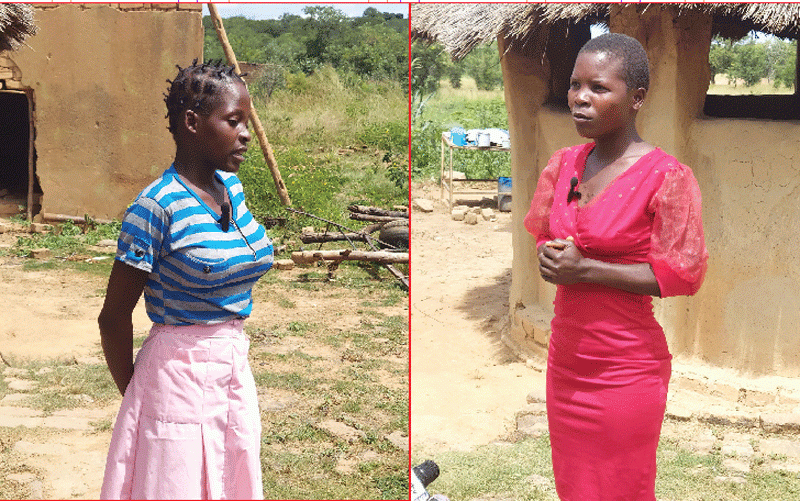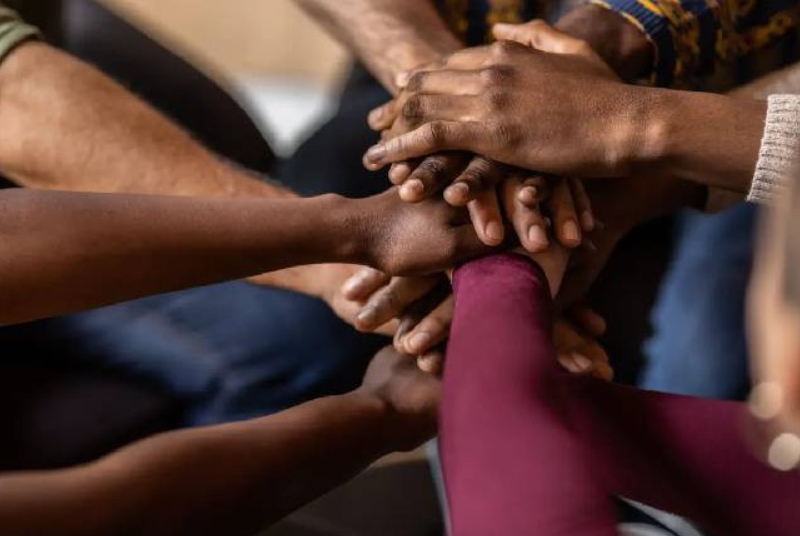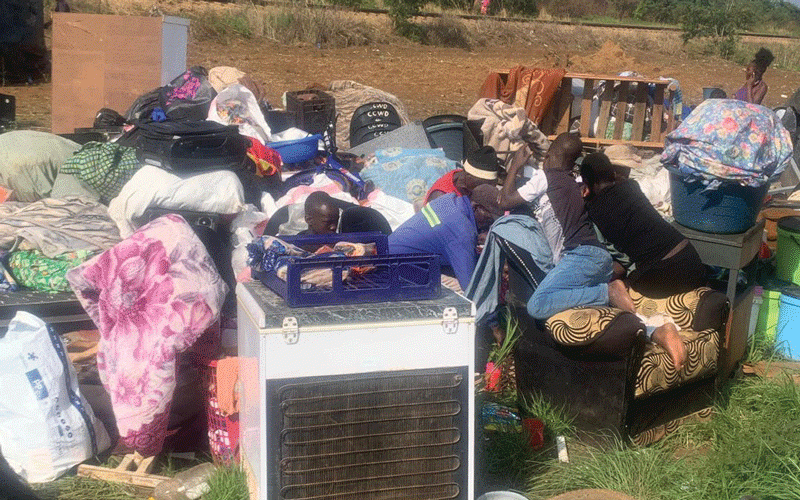
For a myriad of girls in Hurungwe district, the arrival of their first period can mean the end of their school years as they face societal pressures to become brides.
Despite significant progress in recent decades, Hurungwe district in Mashonaland West province, just like many rural communities in the country, still accounts for a large chunk of the country’s child brides.
Approximately one in three girls in Zimbabwe are married before their 18th birthday, according to the United Nations Population Fund, a UN sexual and reproductive health agency.
Child marriage predominantly affects girls who live in poverty, in rural areas and farming communities.
Girls from the poorest 20% of households are more than four times likely to be married/in union before age 18 than girls from the richest 20% of households, UNFPA said.
The less educated a girl is, the more she is likely to marry during her childhood.
Twenty-two-year-old Thandanani Mawunganidze’s dream of being a nurse was shattered after she was forced to drop out of school and get married.
“I was forced to stay at home because my family could not afford paying me school fees,” Mawunganidze said.
- Mavhunga puts DeMbare into Chibuku quarterfinals
- Bulls to charge into Zimbabwe gold stocks
- Ndiraya concerned as goals dry up
- Letters: How solar power is transforming African farms
Keep Reading
“As a result of societal pressure I ended up eloping to one of the guys with the hope of starting a family.
“I had wanted to be a nurse when I completed school, but that dream was shattered.”
Estimates show that 62 primary school girls got married while 79 primary school girls got pregnant in 2024 in Hurungwe district.
About 215 secondary school students got married last year as well.
Alumni of the Sista2Sista Club, Mawunganidze, a mother of, has since divorced.
“We had differences with my husband, especially during the tobacco marketing season,” she said.
“Gender-based violence was the order of the day, which forced me to leave.”
Locardia Dzinoreva (25) from the same village was forced out of her marriage after her in-laws held rigid notions against her church, an apostolic sect, leading to their discriminatory behaviour.
“I was married at a tender age, but my in-laws treated me differently because of religious beliefs,” Dzinoreva said.
“I was very young and I did not have control over my marriage.
“If I was mature enough, I would have stood with my husband, but that was not to be.
“I walked out of the marriage, hoping to restart, go back to school or get some empowerment.
“There are so many girls who have married early and face similar predicaments.”
Dzinoreva conceded that she was enticed into the marriage by the power of tobacco farming.
The tobacco marketing season increases the vulnerability of young women and girls to HIV infection, according to Charity Choruwa, a Hurungwe ward 24, Vhareta village, Chiroti, Sista2Sista mentor.
The Sista2Sista programme aims to enhance the self-efficacy of young women to access and utilise integrated HIV prevention, sexual and reproductive health and gender-based violence services by empowering them to make responsible reproductive health decisions.
“The challenge we are facing with our young women is that they are more interested in money than in safeguarding their health,” she said.
“This makes it difficult to keep tabs on their safety from contracting HIV.
“We also have problems with GBV cases during this season as couples fight over misuse of proceeds from sales, which are usually spent on women (sex workers) by the husbands.”
Choruwa, however, said they were countering the challenges by empowering the young women and girls in her area through projects like floor polish making and dishwashing soap production, among others.
“The turnout is encouraging and they present heightened interest in the programme,” she said.
“The programme is helping as we have also managed to empower them so that they don't fall prey to older men for financial benefits.”
“Since we started, there has been a change, especially in the community.
“We also go to schools to train the young girls so they know that they are not to be taken advantage of because of money and other material things,” she said.
The predicament faced by girls in Hurungwe cut across the country, mainly in rural and farming communities.
Faced with a bleak future after her grandmother decided to pull her out of school while in Grade 7, Tendai Mhere* left her rural home in Murehwa, for Chabwino Farm in Goromonzi, Mashonaland East province.
Just like many of her peers, who are faced with lack of jobs in the nearby farms following the demise of the agricultural sector as a result of the land reform programme, Mhere migrated to Harare where she briefly worked as a maid.
Life in the capital city was not a stroll in the park for Mhere, which saw her returning to Chabwino Farm.
According to her, many young men and women from her rural home and other rural communities in Mashonaland East province moved to farms during the land reform with prospects for a better life.
“I came here with the hope of completing Grade 7 and proceeding to secondary school,” Mhere said.
“Just like my peers, we thought life would be better at the farms than at home.”
Mhere later completed Grade 7 at primary school within the farm compound, but did not proceed to Form 1 before she moved to Harare.
“I couldn’t proceed to Form 1 because there was no money for school fees, instead I was referred to Harare for a job,” she said.
“It was not easy staying in Harare and I came back here to the farm and I got married to one of the farmers.
“I was 16 years old when I got married and when I got to 20, I had two children.
“Most young girls here have been getting married to very old men. In most cases, it’s very difficult for us to make decisions in such marriages.”
Mhere, who was among scores of people from Chabwino Farm and the surrounding farming community who had come for a health outreach exercise at Chabwino Farm, said most women of her age were on the receiving end when it comes to HIV and sexually-transmitted infections (STIs).
“I have seen my friends infected by STIs and HIV. This is rampant here in the farm compounds,” she said.
A myriad of families migrated to Chabwino Farm, which was one of the thriving farms in the country, at the height of the land reform programme. Men go to the fields while women have to settle for domestic work.
According to a survey conducted by the Zimbabwe Farmers’ Union, agricultural output in communal areas declined by nearly 50% among households affected by HIV and Aids in relation to households not affected by the pandemic.
The survey also noted that maize production by smallholder farmers and commercial farms declined by 61% because of illness and death due to Aids.
Marketed output of cotton, vegetables, and groundnut and sunflower crops was cut nearly in half and cattle farming declined by almost a third.
The National Aids Council (NAC), has come up with several HIV intervention approaches to revolutionise and scale up prevention services to communities, including farms and rural communities.
One such approach is the Sista2Sista model.
“The Sista2Sista Club is one of the HIV intervention models that we are implementing here in Hurungwe specifically targeted at adolescent girls and young women,” said NAC district Aids coordinator for Hurungwe Admire Takawira.
“NAC is also implementing other complimentary models in the districts aimed at preventing new infections among vulnerable groups, in our case adolescent girls and young women.
“We have the DREAMS programme, which also focuses on reducing new HIV infections among adolescent girls and young women aged 10 to 24 years who are vulnerable and at risk of getting HIV infection.”
Takawira said NAC was also implementing the Brotha2Brotha approach in the district, which focuses on addressing sexual reproductive health needs of adolescent boys and young men.
He said the Behaviour Change Community Motivator (BCCM) was being executed in the district to encourage individuals and communities to change their HIV-related behaviour.
Takawira said behavioural interventions for HIV prevention are applied to promote change in sexual behaviour, and to increase HIV service utilisation and adherence to HIV services and behaviours.
To achieve this, the interventions commonly address knowledge, attitudes, risk perception, norms, HIV service demand and skills, he said.
“The district will soon implement the Not In My Village model, an approach that seeks to harness community and traditional leaders’ influence to create a supportive environment for adolescent girls,” Takawira said.
“We are also going to implement another model on community engagements as we seek to embrace the vast potential of community-driven solutions in tackling the critical issue of child marriages in Hurungwe.”
He said NAC working with its partners was implementing a wide range of intervention programmes in Hurungwe, targeting HIV hotspots.
He said last year a total of 4 289 STIs were reported in Hurungwe district, with HIV hotspots constituting the highest figures.
Hurungwe district’s HIV incidence is 0.06% and the population of people living with HIV is 34 271.
He said several intervention programmes targeted at HIV hotspots have had a great impact in the response to HIV and Aids.
Girls and Women Empowerment Network Trust director Kumbirai Kahiya said communication and dialogue led by traditional and community leaders within communities were the panacea to breaking the culture of silence around gender-based violence, including child marriages.
“They are very important, dialogues reveal the attitudes and beliefs held in communities. However, they must be strategic and contextual,” she said.
“At times, it's important to have girls, boys, women, and men separately in dialogues so that we capture the different issues.
“Then we get back to mixed groups and break down issues discussed without mentioning names or pointing fingers.”
Chief of party at Zimbabwe Health Interventions Tichaona Nyamundaya said girls who marry young were more likely to drop out of school, reducing their access to information about sexual and reproductive health, including HIV prevention.
“Child marriages often perpetuate poverty, which is a key structural driver of HIV,” Nyamundaya said.
“Economic dependence on a partner limits a young girl’s ability to leave risky or abusive situations or seek care.
“Combating the problem of child marriage and its link to HIV requires a multi-sectorial, holistic approach that addresses the root causes and provides support at multiple levels; community, institutional, and policy.”
He said there was need to strengthen legal and policy frameworks through enforcing minimum age of marriage laws (usually 18+) and close legal loopholes that allow child marriage with parental consent.
“There is a need to align national policies with international human rights standards such as Cedaw (Convention on the Elimination of All Forms of Discrimination against Women) and CRC (Convention on the Rights of the Child),” Nyamundaya said.
“Child marriage prevention should be integrated into national HIV strategies and gender-based violence frameworks.
“Education is one of the strongest protective factors against early marriage and HIV, so there is a need to promote girls’ education.”
Nyamundaya said empowering girls and young women by supporting them with life skills training was essential so as equipping them to make informed decisions about their health, relationships, and futures.
“There is a need to engage communities and shift social norms through working with parents, traditional leaders, and religious figures to challenge harmful norms around early marriage,” he said.
“Use community dialogue, media campaigns, and storytelling to shift perceptions and promote positive alternatives.
“Engage boys and men as allies to support gender equality.”










